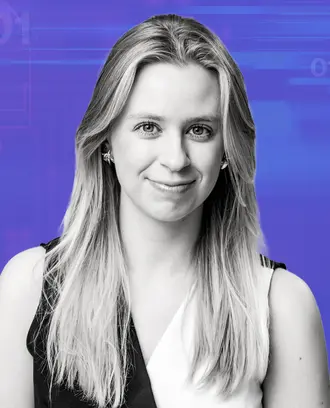Credit: Stephen Sauer
TIAA CEO Roger Ferguson gets ideas from ‘inside out’ and ‘outside in’
Roger Ferguson categorizes ideas as starting either “outside in” or “inside out.” The former is developed by examining the outside world and working with clients and external partners. The latter is well-earned, derived from the experience and expertise of the 102-year-old organization he helms. Both are necessary and are best when they work together.
As president and CEO of TIAA, the Teachers Insurance and Annuity Association, Ferguson leads an organization where both sources of ideas are tapped to serve the guiding purpose of helping people achieve financial well-being and retirement security. The nonprofit financial services firm sits at 79 on the Fortune 500 list and had nearly $1 trillion in assets under management as of last year. Ferguson spoke last month in Corporations at the Crossroads: The CEO Perspective, a course taught by MIT Sloan dean David Schmittlein and former MIT president Susan Hockfield. We asked him how he develops and works with ideas.
What inspires you?
Ultimately, what inspires me is trying to help people. When I think about the various things I’ve done in my career, many have been oriented toward helping. One reason I wanted to be a consultant was to help businesses solve problems. In my public service at the Federal Reserve, I was helping to move the country forward in important ways and create better economic outcomes for Americans. And leading TIAA is very much about helping people to achieve financial wellness and financial security.
Who inspires you?
I have always been inspired by people whose stories involve growth and development. As a teenager, I idolized Andrew Brimmer, who started out as the son of sharecroppers and ended up being a Federal Reserve governor — the first African American to achieve that distinction. I’m also inspired by people who combine sharp minds and soft elbows — people who have what it takes to make it to the top of their profession but are also still human and empathetic. I’ve had several great examples of that in my life, including Jim Goodrich, who was the chief administrative officer at McKinsey & Co., and Richard Caves, an economics professor at Harvard. To me, the people who can succeed without being hard-edged are the best role models.
Where do you get ideas?
There’s no single source for ideas. I get my ideas from doing an awful lot of reading, especially biographies and histories. At the moment, I’m reading “The Great Influenza,” a history about the 1918 Spanish flu epidemic and its aftermath. I also get ideas from being in interesting conversations with people who are smarter and more experienced than me, and trying to learn from them. I take the time to think about what I’m learning and to look for connections that may not be obvious. At the end of the day, it’s a combination of listening and learning, trying to see connections, and taking time to reflect on how these various elements might come together as a new concept or way of doing things.
How are new ideas discovered and developed in your organization?
We take both an “outside in” and an “inside out” approach. An example of the former is listening to our clients to understand how their needs are changing. An example of the latter is looking closely at TIAA’s great strengths, particularly around promoting financial wellness and using financial tools to help solve people’s problems, and putting those things together in creative ways.
We recently launched a new product that combines target date funds and annuities as a way to enhance retirement outcomes. We co-developed it with a client who really understands the value of annuities. It’s a great example of leveraging what we see in the world (outside in) with what we know how to do so well after 102 years of history (inside out).
How do you keep track of new ideas?
In a healthy organization, the CEO probably knows about only a small fraction of the ideas that are being developed. Many of the best ideas come from the frontline folks, the people who are running the business on a day-to-day basis. But you never know where good ideas will come from. A few years ago we developed a tool to help our institutional clients assess the retirement readiness of their retirement plan participants. It’s become a highly successful offering for us. The idea for it came from someone who was at that time in the communications area, not the retirement business. It’s an example of how great ideas don’t follow any kind of hierarchy — and they don’t reside in just one part of the organization.
How do you test ideas?
New ideas have to be tested by the people who understand what the market wants and what we can deliver — and I mean that in the day-to-day, practical sense of whether we can actually build a system to make the idea happen, whether we can actually figure out how to present it in a way that’s compelling, and whether we can find clients who want it. You test new ideas by getting as close to the application expertise as you possibly can.
When do you know it is time to abandon an idea?
Knowing when to abandon an idea is one of hardest things. An idea may be based on what one thinks the marketplace needs and should want, but it may be ahead of its time. An example is TIAA’s creation of the world’s first variable annuity, CREF, in 1952. It was not a success initially, and in fact it was openly criticized, because the concept of investing people’s retirement money in equities was contrary to the thinking at the time. But it eventually came to be called [by Fortune magazine] “the biggest development” in our industry since Social Security. So you never want to abandon new ideas too quickly. If I think an idea is good in abstract, I’ll tend to let it run a little longer than others might.
What was your worst idea?
It’s tough to answer that question, as I don’t believe there are “bad” ideas if the intention is genuine. I’ve certainly had ideas that didn’t work out. But an idea can fail for many reasons: maybe it wasn’t presented the right way, or it wasn’t executed well, or the timing wasn’t right. On a personal level, I can readily say that my worst idea was deciding to rent a car with a stick shift on my honeymoon on Martinique, which happens to have plenty of hills. If you’re not good at driving a stick shift — and I wasn’t — it’s very easy for the car to stall out on hills. That happened a lot during the week we were there, and my new bride was not amused!
How do you know an idea is a good one?
You know an idea is a good one when the market runs to it. But I also believe that there’s no such thing as a permanently good idea, where you can just “set it and forget it.” Even one of the best ideas ever —the annuity — has had to evolve and change over time. That’s why TIAA — founded to provide retirement security through fixed annuities — eventually created the variable annuity. We’ve continued to innovate as you can never be complacent. Circumstances change, and you should always be thinking about how you must evolve to stay relevant.
What's the biggest idea you are working on right now?
We’re bringing together asset classes in new and different ways to help create more retirement security, like combining annuities and target date funds, for example. We also have lifecycle funds where we’re combining equities and real estate investment products in lieu of fixed income. Our goal is to create better outcomes for our clients. In the process, we’re trying to help solve a huge societal problem — the need for more retirement security — and to do it in a way that doesn’t require people to have deep financial literacy or to have to make overly complex financial decisions.
At MIT Sloan, we talk about ideas made to matter — ideas that are carefully developed and have meaningful impact in the world. In that context — what is your idea made to matter?
One of the biggest challenges Americans face is ensuring they save enough for retirement — even as they are living longer than previous generations and bearing more responsibility for their own retirement security than ever before. TIAA knows that annuities, which we’ve offered since 1918, are a way to make sure people don’t outlive their savings. We’re bringing a modern approach to this product, which has been around for such a long time, to make it even more relevant to today’s world. We’re driven to succeed because we know that enhancing retirement security will make a huge difference in people’s lives — and in the world.



